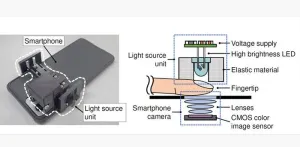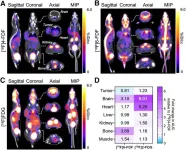(Press-News.org) Diabetes is a very prevalent disease that, unfortunately, still has no treatment. People with diabetes need to monitor their blood glucose levels (BGLs) regularly and administer insulin to keep them in check. In almost all cases, BGL measurements involve drawing blood from a fingertip through a finger prick. Since this procedure is painful, less invasive alternatives that leverage modern electronics are being actively researched worldwide.
Thus far, several methods to measure BGL have been proposed; using infrared light is a prominent example, and mid-infrared light-based devices have shown reasonable performance. However, the required sources, detectors, and optical components are costly and difficult to integrate into portable devices. Near-infrared light (NIR), in contrast, can be readily produced and detected using inexpensive components. Many smartphones and smartwatches already use NIR sensors to measure heart rate and blood oxygen levels. Unfortunately, glucose does not have unique absorption peaks in the NIR region, and it is therefore difficult to distinguish it from other chemicals in the blood, such as lipids and proteins.
To tackle this limitation, a research team led by Tomoya Nakazawa of Hamamatsu Photonics (Japan) recently developed a novel methodology to estimate BGLs from NIR measurements. Their work, which could revolutionize noninvasive blood glucose monitoring, was published in the Journal of Biomedical Optics.
The core contribution of this study is a new blood glucose level index that the research team derived from basic NIR formulas. Their approach begins with the extraction of oxyhemoglobin (HbO2) and deoxyhemoglobin (Hb) signals from NIR measurements. Through the analysis of massive amounts of data on NIR measurements, the researchers realized that the phase delay (asynchronicity) between the low-frequency and oscillating components of HbO2 and Hb signals is closely related to the degree of oxygen consumption during each cardiac cycle, thereby serving as a gauge for metabolism. “This phase delay-based metabolic index, which has not been reported by other researchers, is a scientifically important discovery,” remarks Nakazawa.
The team then sought to prove the relationship between this newfound metabolic index and BGLs through a series of experiments. First, they used the NIR sensor on a commercial smartwatch by placing it over the finger of a healthy subject at rest. The subject then consumed different sugary and sugar-free beverages to induce changes in blood glucose. Similar experiments were conducted using a custom smartphone holder with a high-brightness LED. The results were very promising, as the changes in the metabolic index closely matched variations in blood glucose levels measured by a commercial continuous glucose monitor. This confirms that the phase delay between the HbO2 and Hb is indeed closely correlated with BGLs.
Clinical tests on diabetic individuals are pending to confirm the applicability of the metabolic index in a real-world context. Still, the researchers have high hopes for their innovative technique, as Mr. Nakazawa states: “The proposed method can in principle be implemented in existing smart devices with a pulse oximetry function and is inexpensive, battery-saving, and simple compared with other noninvasive blood glucose monitoring techniques. Thus, our approach could be a powerful tool towards portable and accessible BGL monitoring devices in the future.”
Let us hope these efforts contribute to practical, noninvasive ways for people with diabetes to keep their BGLs under control, thereby minimizing the impact of their disease!
For details, see the original Gold Open Access article by Nakazawa et al., “Non-invasive blood glucose estimation method based on the phase delay between oxy- and deoxyhemoglobin using visible and near-infrared spectroscopy,” J. Biomed. Opt. 29(3), 037001 (2024), doi 10.1117/1.JBO.29.3.037001.
END
Lighting the way to noninvasive blood glucose monitoring using portable devices
A novel approach to estimate metabolic activity and infer blood glucose levels from near-infrared measurements in commercial smartphones and smartwatches
2024-03-08
ELSE PRESS RELEASES FROM THIS DATE:
What's behind the surge of fatty liver disease in Latinx kids?
2024-03-08
For Latinx kids, unreliable access to food at age 4 raises the odds of having fatty liver disease later in childhood by nearly four times, a new UC San Francisco-led study found.
About 5% to 10% of children in the United States have nonalcoholic fatty liver disease, putting its prevalence on par with asthma. Pediatric cases have spiked in the last decade, with millions now affected by a disease marked by pain, fatigue and jaundice that can lead to cirrhosis, cancer and organ transplantation. Latinx children and adults ...
nTIDE February 2024 Jobs Report: Overall employment trend still positive despite recent declines for people with disabilities
2024-03-08
East Hanover, NJ – March 8, 2024 – Despite recent declines in the labor force participation rate and employment-to-population ratio, the overall employment trend remains positive for people with disabilities, according to today’s National Trends in Disability Employment – semi-monthly update (nTIDE), issued by Kessler Foundation and the University of New Hampshire’s Institute on Disability (UNH-IOD).
Month-to-Month nTIDE Numbers (comparing January 2024 to February 2024)
Based on data from the U.S. Bureau of Labor Statistics ...
Locating single neurons that monitor and regulate the heart and lungs
2024-03-08
The body self-regulates in a process known as homeostasis, and the brain is responsible for this
as it is constantly monitoring all of the body’s vital signals. If you need more oxygen, for
example, then a message is sent to the brain that then tells the body to adjust your breathing
and your heart rate. But the neurons involved in regulating breathing and cardiac rhythm had
never been directly observed, until now, thanks to brain recording technology during brain
surgery.
EPFL neuroscientists, in a collaboration with surgeons and neuroscientists at West Virginia
University Rockefeller Neuroscience ...
Primary care scarcity linked to more surgical emergencies & problems
2024-03-08
America’s shortage of primary care doctors and nurse practitioners has a downstream effect in the nation’s operating rooms, a new study finds.
And patients suffer as a result.
In all, people living in areas with the most severe shortages of primary care providers have a much higher risk of having emergency surgery, rather than a scheduled operation,
compared with people with the same condition who live in areas with less-dire primary care shortages.Those living in the areas with the lowest availability of primary care providers ...
Novel PET tracer maps fructose metabolism to identify cardiac and neural disorders
2024-03-08
Reston, VA—A new PET radiotracer can differentiate diseased tissues from healthy tissues based on fructose metabolism, according to new research published in the March issue of The Journal of Nuclear Medicine. Fructose metabolism—or fructolysis—is indicative of a variety of diseases, and by noninvasively mapping fructolysis physicians can more accurately detect diseases and treat them earlier.
Glucose is used as the primary biochemical fuel throughout the body, powering key processes like tissue function, growth, and repair. Glucose is also consumed extensively during inflammation and cancer growth and can be visualized with PET scans. Evidence continues to mount that ...
Pushing the boundary on ultralow frequency gravitational waves
2024-03-08
A team of physicists has developed a method to detect gravity waves with such low frequencies that they could unlock the secrets behind the early phases of mergers between supermassive black holes, the heaviest objects in the universe.
The method can detect gravitational waves that oscillate just once every thousand years, 100 times slower than any previously measured gravitational waves.
“These are waves reaching us from the farthest corners of the universe, capable of affecting how light travels,” said Jeff Dror, Ph.D., an assistant ...
New study reveals molecular fingerprint of biological aging
2024-03-08
University of Pittsburgh researchers have uncovered blood-based markers linked with healthy and rapid aging, allowing them to predict a person’s biological age — how fast a person’s cells and organs age regardless of their birthdate.
The new research, published in Aging Cell, points to pathways and compounds that may underlie biological age, shedding light on why people age differently and suggesting novel targets for interventions that could slow aging and promote healthspan, the length of time a person is healthy.
“Age is more than just a number,” said senior author Aditi Gurkar, Ph.D., assistant professor of geriatric medicine at ...
Glowing flowers illuminate homes and gardens with organic light
2024-03-08
Sun Valley, ID - March 8, 2024 – Recent discoveries published in Science Advances have unveiled a native plant gene that enables researchers to more effortlessly harness the captivating glow of bioluminescent plants. This gene, which varies across different plant species, allows for the redirection of living energy into organic light. The advancement reveals the intricate inner rhythms and dynamics of plants through continuously evolving luminosity, offering a natural source of illumination for homes, gardens, and beyond.
The study received support from Light Bio, a pioneer in the development of bioluminescent plants. Light Bio is dedicated to fostering ...
Research sheds light on new strategy to treat infertility
2024-03-08
New research from Oregon Health & Science University describes the science behind a promising technique to treat infertility by turning a skin cell into an egg that is capable of producing viable embryos.
Researchers at OHSU documented in vitro gametogenesis, or IVG, in a mouse model through the preliminary steps of a technique that relies upon transferring the nucleus of a skin cell into a donated egg whose nucleus has been removed. Experimenting in mice, researchers coaxed the skin cell’s nucleus into reducing its chromosomes by half, so that it could then be fertilized ...
The brain builds emotions regardless of the senses
2024-03-08
How much do our emotions depend on our senses? Does our brain and body react in the same way when we hear a fearful scream, see an eerie shadow, or smell a sinister odor? And does hearing an upbeat music or seeing a colorful landascape bring the same joy?
In an innovative study published in Science Advances, researchers have unveiled new insights into the intricate relationship between emotion and perception.
Led by a team of Italian neuroscientists from the IMT School for Advanced Studies Lucca, and conducted in collaboration with the University of Turin, the research project investigates whether the brain employs sensory-specific or abstract codes to construct ...
LAST 30 PRESS RELEASES:
NIH-led study reveals role of mobile DNA elements in lung cancer progression
Stanford Medicine-led study identifies immune switch critical to autoimmunity, cancer
Research Alert: How the Immune System Stalls Weight Loss
Glucagon-like peptide 1 receptor agonist use and vertebral fracture risk in type 2 diabetes
Nonadherence to cervical cancer screening guidelines in commercially insured US adults
Contraception and castration linked to longer lifespan
An old jeweler’s trick could unlock next-generation nuclear clocks
Older age, chronic kidney disease and cerebrovascular disease linked with increased risk for paralysis and death after West Nile virus infection
New immune role discovered for specialized gut cells linked to celiac disease
A new ‘hypertropical’ climate is emerging in the Amazon
Integrated piezoelectric vibration and in situ force sensing for low-trauma tissue penetration
Three-hit model describes the causes of autism
Beech trees use seasonal soil moisture to optimize water uptake
How thinning benefits growth for all trees
Researchers upgrades 3-PG forest model for improved accuracy
Achieving anti-thermal-quenching in Tb3+-doped glass scintillators via dual-channel thermally enhanced energy transfer
Liquid metal modified hexagonal boron nitride flakes for efficient electromagnetic wave absorption and thermal management
Failure mechanisms in PEM water electrolyzers
Study captures how cancer cells hide from brain immune cells, shows that removing their “don’t eat me” signals stops their escape
New breakthrough in detecting ‘ghost particles’ from the Sun
Half of people arrested in London may have undiagnosed ADHD, study finds
From dots to lines: new database catalogs human gene types using ’ACTG’ rules
Persistent antibiotic resistance of cholera-causing bacteria in Africa revealed from a multinational workshop for strengthening disease surveillance
SwRI, Trinity University to synthesize novel compound to mitigate effects of stroke, heart attack
Novel endocrine therapy giredestrant improves disease-free survival over standard of care for patients with early-stage breast cancer in phase III lidERA trial
Gen Z views world as "scary place" with growing cynicism about ability to create change
Biosensor performance doubled – New applications possible
Leveraging incomplete remote sensing for forest inventory
Key chemical in dark chocolate may slow down ageing
New 15-minute hepatitis C test paves the way for same-day treatment
[Press-News.org] Lighting the way to noninvasive blood glucose monitoring using portable devicesA novel approach to estimate metabolic activity and infer blood glucose levels from near-infrared measurements in commercial smartphones and smartwatches




